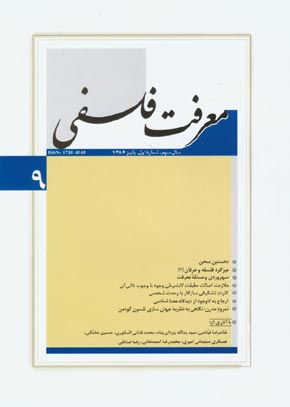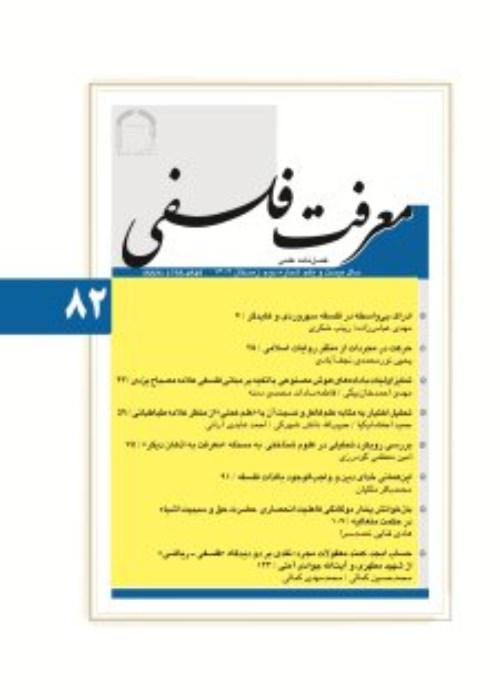فهرست مطالب

فصلنامه معرفت فلسفی
سال سوم شماره 1 (پیاپی 9، پاییز 1384)
- 156 صفحه، بهای روی جلد: 24,000ريال
- تاریخ انتشار: 1384/12/15
- تعداد عناوین: 8
-
صفحه 7
-
میزگرد فلسفه شناسی (8) / رابطه فلسفه و عرفان (2) / با حضور حجج الاسلام و المسلمین استاد غلامرضا فیاضی، سید یدالله یزدان پناه، دکتر محمد فنائی اشکوریصفحه 11در این نشست، در باب رابطه فلسفه و عرفان، به جایگاه فلسفه و عرفان اسلامی و مناسبات آن دو اشاره شده است. در تاریخ فلسفه اسلامی، هرچه به پیش می آییم، احساس می کنیم که فلسفه و عرفان به هم نزدیک شده اند. در آثار فلاسفه متاخر، این بحث به گونه ای به هم آمیخته که گاهی برای افراد عادی، تفکیک یک متن فلسفی از یک متن عرفانی آسان نیست. سوال این است که آیا فلسفه و عرفان، دو علم و دو نوع معرفت متمایز هستند? اگر دو نوع معرفت هستند، وجه تفاوت و تمایز و اشتراکاتشان به چیست?...
کلیدواژگان: تجربه عرفانی، حکمت، فلسفه، برهان، عرفان نظری، شهود عرفانی -
صفحه 45سهروردی با استفاده از سنت های کهن عقلی و اشراقی ایرانی و یونانی و میراث فکری و معنوی اسلامی، نظام فلسفی بدیعی تاسیس کرد که حکمت اشراقی نام دارد. مفهوم محوری در این نظام بدیع، مفهوم نور است. نور حقیقتی است ذومراتب که از نورالانوار تا نور حسی را شامل می شود. حقیقت معرفت نیز نور ذومراتب است. سرچشمه و نقطه آغاز معارف بشری معرفت حضوری است. احساس نیز درک بی واسطه و حضوری است که با اشراق نفس حاصل می شود. سهروردی همچون دیگر حکمای اسلامی، به شناخت عقلی انتزاعی نیز قایل است و معارف بدیهی و منطق را برای این منظور ضروری می داند...
کلیدواژگان: سهروردی، حکمت اشراق، حکمت مشا، معرفت شناسی، علم حضوری، علم اشراقی، نور -
صفحه 69حقیقت لابشرطی وجود، اصیل است و به ادله ای که خواهد آمد اصالت او با وجوب ذاتی آن ملازمت دارد. بنابراین، واجب الوجود بالذات است و چون واجب الوجود هیچ گونه کثرتی را نمی پذیرد پس از حقیقت از هر گونه کثرت عزلی یا تشکیکی به دور است. در این مقاله، انتقادات وارد بر ملازمه اصالت وجود با وجوب ذاتی آن طرح، سپس به آنها پاسخ داده شده است.
کلیدواژگان: حقیقت لابشرطی وجود، وجوب ذاتی، موجود بالذاتی، اصالت وجود -
صفحه 83یکی از دغدغه های فلسفی در عرفان و حکمت متعالیه، مسئله وحدت وجود است. عرفا قایل به وحدت شخصی وجود هستند، در حالی که در فلسفه و بخصوص در حکمت متعالیه، کثرت وجود بدیهی یا قریب به بدیهی تلقی شده است. شاه کار صدرالمتالهین اصالت وجود است که از تحلیل آن، تشکیک وجود و عین الربط بودن معلول نسبت به علت فاعلی استنتاج می شود و از این رهگذر، وی گامی به سوی وحدت شخصی وجود برداشته و به مدعای عرفا نزدیک شده، بلکه حتی آن را برهانی کرده است...
کلیدواژگان: اصالت وجود، وحدت وجود، تشکیک وجود، وجوب ذاتی، مواد ثلاث، امکان ماهوی، امکان فقری، امتناع -
صفحه 107یکی از مباحثی که اندیشه فیلسوفان و اندیشمندان را در غرب و شرق به خود مشغول ساخته، تعیین ارزش صدق جملات دارای لفظ لاوجود و نیز چگونگی درک محتوای معنایی این جملات می باشد، به طوری که هیچ فیلسوفی را نمی توان یافت که به این موضوع نپرداخته باشد. اما تا جایی که نگارنده مطلع است تاکنون بررسی معنی شناختی صرف، دست کم در زبان فارسی در قالب زبان شناسی درباره الفاظ لاوجود صورت نگرفته است. هدف از نگارش این مقاله طرح فرضیه ای تازه در زمینه چگونگی ارجاع و طبقه بندی الفاظ لاوجود از دیدگاه معنی شناسی زبانی می باشد...
کلیدواژگان: لاوجود، لفظ ارجاعی، ارجاع، برون مرکز، درون مرکز -
صفحه 125نظریه جهان سازی نلسون گودمن تلاشی است برای حل مشکل اصلی نظریه های نسبیت گرایانه ای که در چند دهه اخیر بر فلسفه غرب سیطره داشته اند. چگونگی صدق هم زمان باورهای متناقض مشکل اصلی و مشترک نظریه هایی مانند پلورالیسم معرفتی، تعدد قرائت ها و انسجام گرایی به شمار می رود. گودمن برای حل این مشکل وجود یک جهان از پیش ساخته شده را انکار می کند و از وجود جهان های متعددی که با نمادها و قرائت های بشری ساخته شده اند دفاع می کند. براین اساس، اگر جهان های بی نهایتی وجود داشته باشند، امکان صدق باورهای متناقض بشری فراهم خواهد شد...
کلیدواژگان: وجود شناسی، خلقت، تعدد قرائت ها، نزاع رئالیسم، ضدرئالیسم
-
Page 11The place of Islamic philosophy and mysticism and their interaction are discussed in this session of the series of discussions about the relation between philosophy and mysticism. The more the history of the Islamic philosophy has proceeded, the closer allies these two fields of study have become. In the more recent works of Muslim philosophers, the issues are so mixed that it is hard to distinguish a philosophical text from a mystical one. The question, then is whether there are two realities, two disciplines, and two types of knowledge? If there are two types of knowledge, what are their differences and commonalities? And how they are understood? Issues raised in this discussion include the difference between factual experience and mystical experience, the position of “?ikmat” among other philosophical schools, the rise of theoretical mysticism, the interaction between theoretical mysticism and philosophy, the methodology of comparing philosophy and mysticism, the status of intuition (shuhūd) and religious law (sharī‘at) for Muslim mystics, and the correlation between philosophy and mysticism in the west.
-
Page 45Benefiting from the old intellectual and illuminative traditions of Iran and Greece, as well as the rational and spiritual heritage of Islam, Suhrawardi created an exquisite philosophical system, called “Illuminative philosophy”. The pivotal concept in this sophisticated system is the notion of “light”, which is a multi-level reality, extending from “the Light of lights”, to the visible light. The reality of knowledge is also hierarchical. For him, the fountainhead and the beginning point of human knowledge is knowledge by presence. Sense perception is considered an instance of knowledge by presence, generated by an illumination by the soul. Suhrawardi, as other Muslim philosophers, also believes in an abstract rational knowledge, and considers logic and self-evident statements necessary elements in this regard. However, the real—and for him, supreme—knowledge is the intuitively illuminative knowledge. This kind of unparalleled comprehension is unattainable through mere reflection and academic discourse. It needs self-purification, detachment from temporal bonds, esoteric journey, and focusing on the almighty God. In this way, Suhrawardi was able to introduce a comprehensive system of knowledge by coordinating philosophically acquired knowledge with mystically intuitive one.
-
Page 69The author in this article argues that the non-conditioned reality of existence is principal (A©īl), and its principality is concomitant with its essential necessity. Therefore, the non-conditioned reality of existence is necessarily existent by itself. And since a necessarily existent does not allow any plurality, then this non-conditioned reality is clean of any kind of plurality. The article proceeds by explaining some critiques against this claim and answering them.
-
Page 83The issue of the “Unity of Existence” is one of the philosophical preoccupations in mysticism as well as al-?ikmat al-Muta‘ālīyah. While mystics believe in the personal unity of existence, in philosophy, and especially in al-?ikmat al-Muta‘ālīyah the plurality of existence is deemed self-evident of approximately so. The crowning achievement of uadr al-Muta’allihīn is “the essentiality of existence”. Analyzing this notion, he derives the gradation of existence, and the idea that an effect is the very relation to its creating cause. In this way, he takes a step toward the idea of personal unity of existence as claimed by the mystics, and rationalizes it. This article tries to show that the personal unity of existence in Mullā uadrā is compatible with its gradation, and therefore, one cannot reject the existence of things that are not necessarily existent all together, and consider them null and void.
-
Page 107Deciding about the truth value, as well as the semantic content, of sentences that include the term “non-existence” has occupied the mind of philosophers and scholars from the east to the west. This issue is so demanding that one cannot find any philosopher who has not dealt with these questions. Despite this fact, to the knowledge of the author of this article, at least in Persian, no pure semantic study has been produced in this regard in terms of linguistics. The author tries to introduce a new hypothesis answering the question as to how we can decide about the reference and the classification of the terms related to non-existence from a semantic point of view. In other words, this article is an attempt at putting forward a new hypothesis in a semantic framework to understand the nature of words about non-existence.
-
Page 125Nelson Goodman’s theory of “worldmaking” is an attempt at solving the main problem of relativistic theories that have dominated the philosophical scene of the western thought in recent decades. The essential and common paradox of such theories as cognitive pluralism, competing true understandings, and coherentism is how to justify simultaneous truth of contradictory beliefs. Aimed at disentangling relativism from such a difficult position, Goodman ignores the existence of a pre-made world, and defends the existence of many worlds constructed by symbols and understandings of different individuals. According to this hypothesis, if there were infinite worlds, concurrent truth of conflicting understandings and beliefs by various individuals becomes possible. This article explains Goodman’s theory and scrutinizes his arguments.
-
ABSTRACTSPage 4


